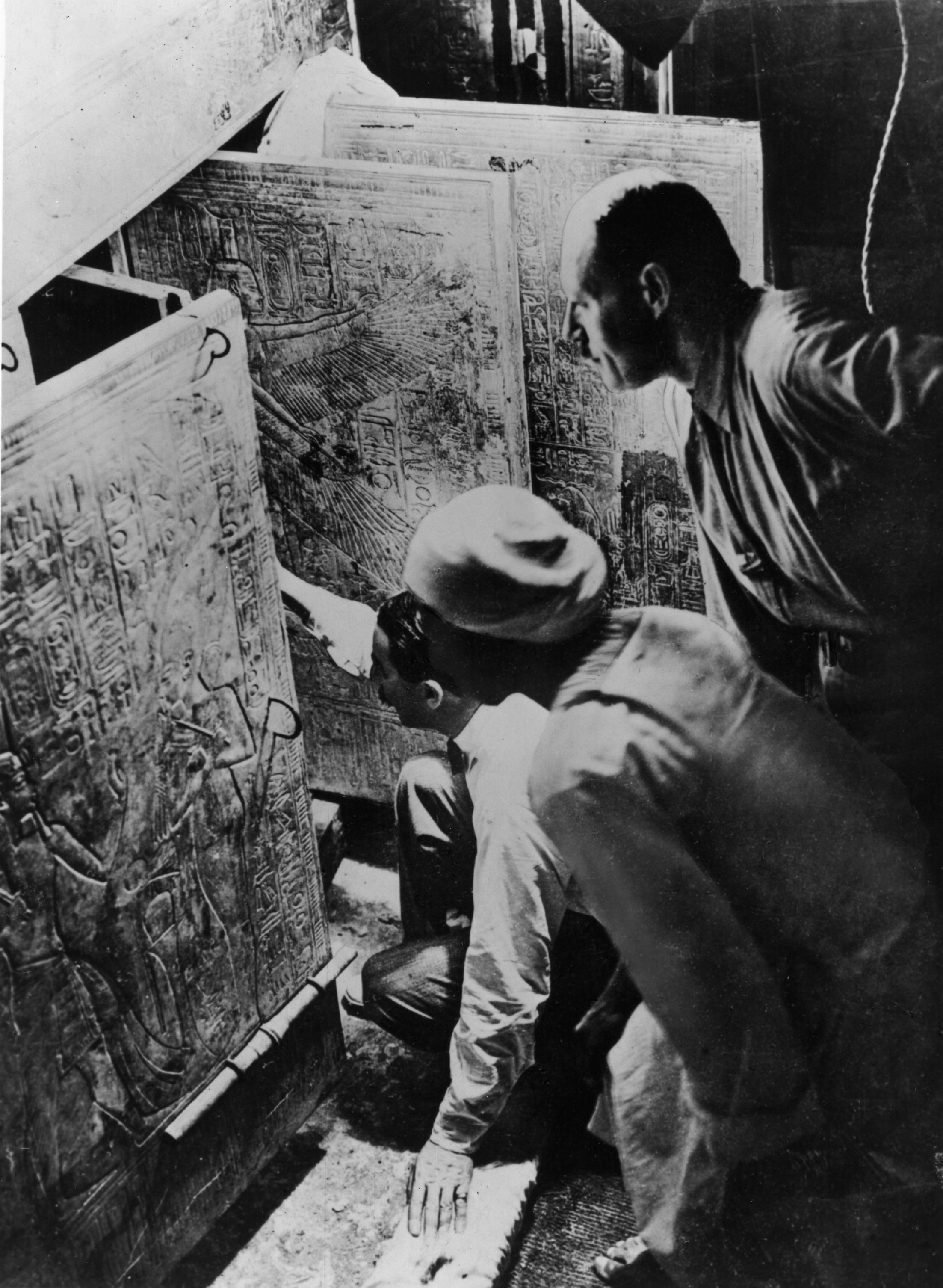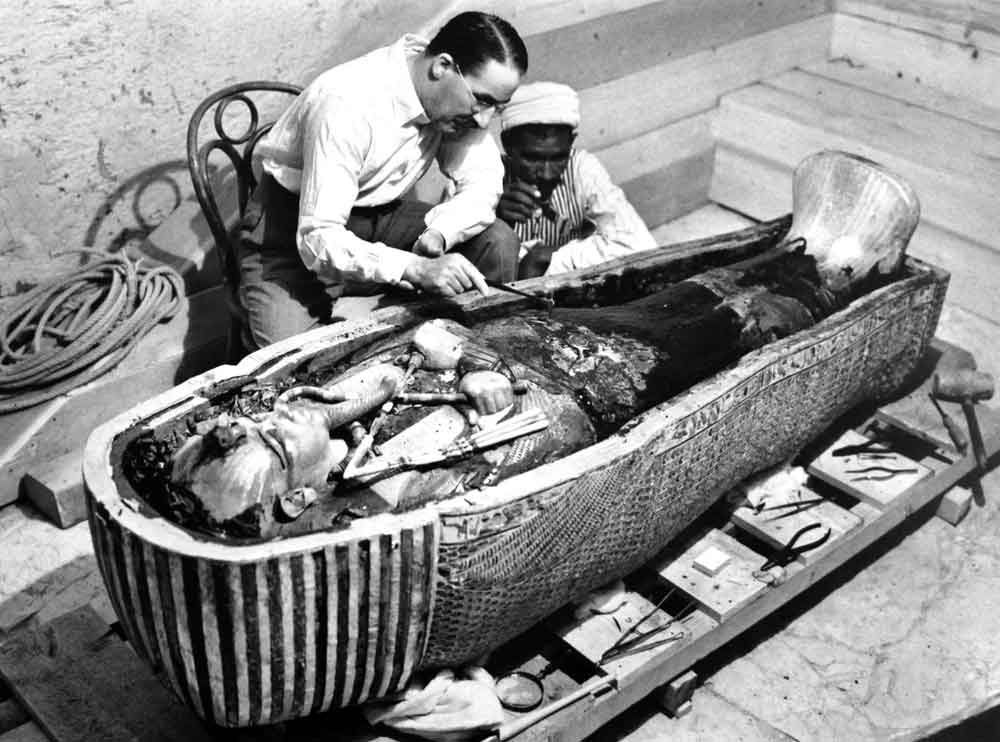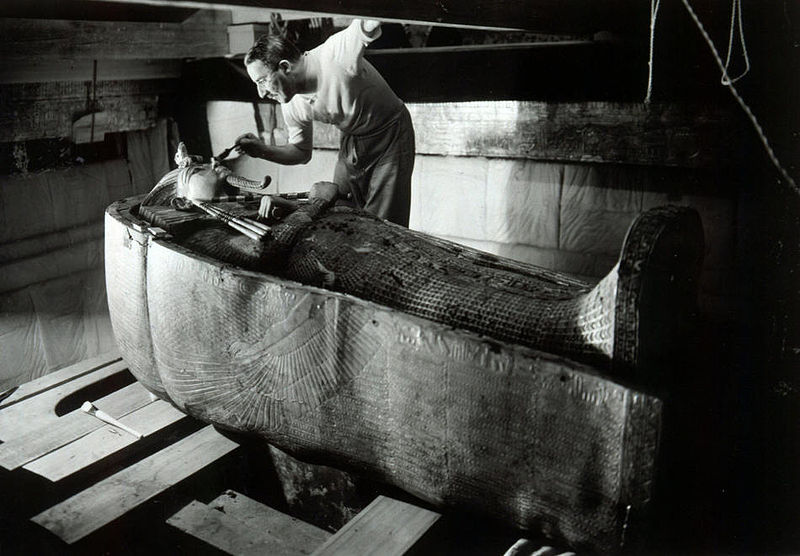The 1970s sensation of the King Tut exhibit obviously had it roots in ancient times, but its modern story began in 1922 when Howard Carter unearthed the unimaginable trove, wonderfully preserved. Soon after the discovery, the New York Times sent a reporter to Egypt to document the find that stunned the world. The article’s opening:
Through the courtesy of Howard Carter, the American Egyptologist, who, as director of Lord Carnarvon’s expedition, has, after thirty-three years’ search dug up the tomb of King Tutankhamen of the eighteenth dynasty, the correspondent of The New York Times was allowed today an exclusive view of the interior of the two ante-chambers of the tomb in the Valley of the Kings in Upper Egypt. The rest of the chambers of the tomb are still sealed.
Down a steep incline we entered straight to the first chamber. In the middle of the wall to the right is a doorway evidently leading to the chamber or chambers wherein doubtless are the sarcophagus and mummy of the King, and perhaps other treasures, since the antechambers are merely a hallway with a drawing room concealed behind a tantalizing sealed door, which will not be opened before the return of Lord Carnarvon from London, which will be about the middle of February.
Against this doorway are two life-size statues of the King made of bitumenized wood–not ebony, as at first reported. They are still standing on reed mats, just as they stood in the King’s palace and exactly as laid down on the Pharaonic funerary ritual. This again is evidence that this is the tomb and not the cache of Tutankhamen, as, if it were the cache the statues would be standing anywhere and anyhow, certainly not in exact accordance with the ritual.
The feet of each statue are shod with solid gold sandals of inestimable value. Each statue is crowned with a golden crown, bearing in front the royal serpent, or uraeus. As Thebes was the shrine of the cult of the serpent this is not unusual.
Incidentally, the day the tomb was opened and the party found these golden serpents in the crowns of the two statues there was an interesting incident at Carter’s house. He brought a canary with him this year to relieve his loneliness. When the party was dining, that night there was a commotion outside on the veranda. The party rushed out and found that a serpent of similar type to that in the crowns had grabbed the canary. They killed the serpent, but the canary died, probably from fright.
The incident made an impression on the native staff, who regard it as a warning from the spirit of the departed King against further intrusion on the privacy of his tomb.
But the most notable thing about the statues is the rare beauty of the faces. They have evidently been made from plaster casts such as were made by the ancient Egyptians a thousand years before the Greeks or Romans ever thought of them. They show the King as a man of royal mien. Gazing on the beautiful, calm, kindly and strong countenance on the left-hand statue, which is undamaged, one finds it difficult to realize that such a monarch could have succumbed to the overwhelming influence among the priests as he did, to become again an adherent of the orthodox religion. The explanation is probably that he realized the futility of opposition to pressure so strong that it even forced the Queen to change her name from Ankhosenaten to Ankhosenamen.
It is certain that the King would not have agreed to his humiliation unless there was no alternative. This fact is historically most interesting as indicating that the power of the Hierarchy of Amon in the days of Tutankhamen was greater than that of Pharaoh, though these sacredotal Princes did not seize the throne from the Pharaohs until more than 300 years later.
As works of art those statues reach a plane of excellence probably higher than has been reached in any subsequent period of the world.
On the other side of the chamber is a throne incomparably magnificent and wondrously beautiful. One must note its infallible evidence of the wholly unsuspected height reached by ancient Egyptian art. The innate refinement, pure lofty estheticism and amazing skill of the craftsman constitute a startling revelation. It shows not only the imperial splendor of ancient Egypt was far more delicate and magnificent than was imagined or equaled in the world’s history, but also that the late greatest craftsmen of ancient Greece were mere hacks compared to the master who designed and adorned the throne.•





